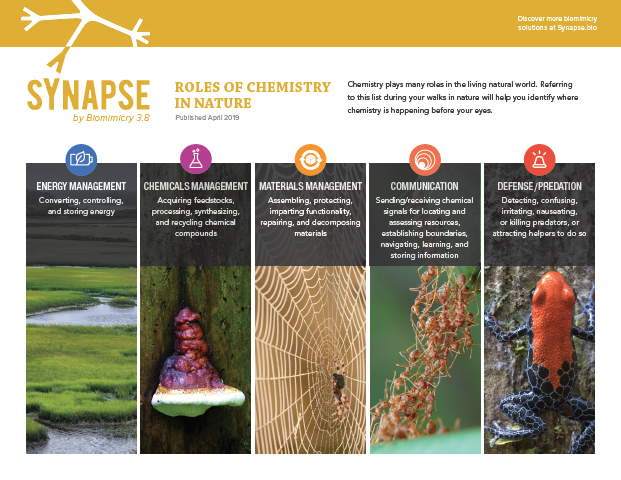Highlights From Our First “Life-Friendly Chemistry” Workshop
by Mark Dorfman, Senior Principal and Lead Chemist
During the first week of March 2019, Biomimicry 3.8 in partnership with NatuR&D held its first week-long immersion workshop on Nature’s Life-Friendly Chemistry in the Satpura Tiger Reserve, Madhya Pradesh, India. This was a long awaited opportunity to share my fascination with, and passion for, the molecular playground that is the living natural world.
Why did we offer a workshop just on Nature’s Life-Friendly Chemistry?
There’s widespread misconceptions that chemicals are man-made entities that contaminate an otherwise chemical-free natural world, but nothing could be further from the truth. The fact is, nature is alive with chemistry! Whether it’s detecting food sources, turning that food into energy, building and managing materials for structure, protection, attracting mates or myriad other functions, chemistry holds the keys.
I’ve personally been fascinated that after 3.8 billion years of R&D, the living natural world has developed elegant chemical strategies that not only solve for the same functional challenges we face from our chemical and material needs, but do so while creating conditions conducive to life. Conversely, many conventional chemical strategies used in commerce have negative impacts on our surroundings, including greenhouse gas emissions affecting climate, micro plastics contaminating the ocean and working their way up the food chain, and persistent synthetic chemicals accumulating in living tissues wreaking havoc on hormonal and other biological systems. My graduate work exposed me to these dangers to public health, which is why I fell in love with biomimicry. A world full of potential solutions at my fingertips!
After many years of practicing biomimicry specific to chemistry, it was finally time to turn that experience into an educational endeavor. I worked to create the first in a series of biomimicry and chemistry workshops to provide a wide range of participants, from product designers to professional chemists, with a fundamental understanding of the principles behind nature’s life-friendly chemistries. Armed with this information, my goal is for participants to build life-friendly principles into their innovations. Product designers will be able to recognize points in the system to intervene and ask the right questions of their chemistry partners, and professional chemists can maximize the incorporation of life-friendly chemistry principles into their inventions.
What experiences did our workshop provide?
Over the course of Biomimicry 3.8’s first week-long immersion workshop, the 12 participants:
Observed chemistry’s role in the living natural world
Learned about nature’s approach to making and managing chemicals and materials
Explored the critical ways in which nature’s chemistry differs from modern commercial chemistries
Identified points of intervention
Experienced how nature’s chemistry strategies can foster the design of novel ways to solve the most pressing sustainability challenges
Enjoyed time outside in nature!
How did the workshop unfold during the week?
The workshop maximized the learning experience through a combination of indoor and outdoor lectures, interactive discussions, hands-on experiments, and plenty of time on safaris through the tiger reserve. The flow, outlined below, was designed to ultimately provide the participants with the tools needed to outline a potential, high-level biomimetic solution to a contemporary sustainability challenge around chemistry.
1. Roles of Chemistry in Nature
Over a decade of biomimicry research, the roles of chemistry in the living natural world started to jell in my mind. As I began compiling them for this workshop, I discovered that some are quite familiar, but others might surprise you. They include chemicals and materials management, energy management, defense/predation, and communications—yes, communication! While Sanskrit is widely regarded as the world’s oldest language at perhaps 4,000 or 5,000 years old, communication through chemistry dwarfs that by at least 100,000 orders of magnitude. Single cell organisms have thrived on Earth for billions of years because they communicate not with words, but by sending and receiving chemical signals—a phenomenon known as quorum sensing. Organisms at every level, even humans, communicate through chemistry. That’s why familiar tastes and smells (molecules that bind with receptors on our tongue or nasal passages) bring back memories, or signal thumbs up or down for everything from food to potential mates. Want to learn more? Be sure to download our “Roles of Chemistry in Nature” infographic at the beginning of this post.
As a fun, interactive learning experience, the organizers of the workshop, Biomimicry Professionals Anjan Prakash and Anne-Marie Daniels, created a “Game Show” style activity where participants were given a prize for each correct natural chemistry-related observation they could describe after each outdoor excursion. The competition was fierce and motivated everyone to offer up all kinds of observations providing us with the opportunity to tease out the important difference between chemistry in the inanimate natural world and chemistry in the living natural world--after all, organisms are constrained by the need to do chemistry in the same place they raise and nurture their young.
For example, one student suggested brilliant colors of rock outcroppings in the local landscape are examples of nature’s chemistry, but it’s important to realize that mineral colors in the inanimate natural world often derive from the inclusion of toxic elements such as lead and cadmium as part of the mineral crystal. Organisms bypass those minerals as a source of color in favor of life-friendly strategies such as developing the organic anthocyanin red/blue pigments common in many fruits, vegetables, grains, and flowers. Pigment-free strategies, called “structural color” use materials with different refractive indices (like air vs. chitin) to cancel or enhance particular wavelengths of incoming light—examples include the brilliant iridescent blue of the morpho butterfly or the glittering gold carapace of the Costa Rican C. aurigans scarab beetle.
2. Chemistry Fundamentals
For some people, the thought of chemistry fundamentals might conjure up traumatic memories of high school chemistry classes, but gratefully it was developed and presented in a most user-friendly way by Timothy L. Ward, Professor Emeritus, Department of Chemical and Biological Engineering at the University of New Mexico.
The purpose of this section was to ensure that participants had the basic vocabulary and understanding needed to get the most out of subsequent discussions on nature’s chemistry. Topics included the periodic table, chemical bonding, reactivity, catalysis, and oxidation. Fun! Truth be told, I loathed the first general chemistry course I took. All of those chemistry fundamentals seemed so divorced from anything in the real world. It wasn’t until I got a summer job working in a lab analyzing Hudson River water for the presence of industrial pollutants that I realized chemistry actually does have a role to play in protecting public health and the environment. Next thing you know, I’m a chemistry major!
3. Nature's Life-Friendly Chemistries: Key Principles
These next two sections were at the heart of the workshop—the secrets behind nature’s chemical wizardry that allow her to do chemistry while creating conditions conducive to life.
The principles discussed include nature’s use of 3D shape complementarity to foster selective reactivity, the dance of self assembly achieved through the strategic placement of attractive and repulsive chemical “decorations” along a carbon-based framework, the supreme use of “weak” bonds to facilitate low energy transformations for both assembly and disassembly, leveraging water’s magical properties for use as solvent, building block, and choreographer, and limiting her palette to a subset of chemical elements arranged in advantageous positions and proportions. An infographic showing the chemical elements used by organisms vs those used in commerce can be downloaded here.
If there are just two words that participants could take away from this workshop, I hope they would be “hydrogen bond”—the relatively weak bonds that are everywhere in Life’s friendly chemistry. Small wonder given the fact that hydrogen is the most abundant element in the universe by sheer number of atoms. Hydrogen bonding is one of the main reasons water is the basis of life and why proteins fold into shapes that make them the workhorses of biology. The tardigrade can survive decades of desiccation because its trehalose sugars form hydrogen bonds with vital cellular components protecting them until the organism is rehydrated. Hydrogen bonds are also the reason cotton fabric will press smoothly from a hot iron.
4. Nature's Life-Friendly Materials: Key Principles
Nature’s materials, like man-made materials, are borne of chemistry. What is it that allows biomaterials to feature multifunctionalities free of the public and environmental health issues associated with man-made materials exhibiting the same set of functional characteristics?
Rather than using the industrial model of adhering disparate materials together and peppering them with potentially toxic additives to achieve multifunctionality, biomaterials use composites of life-friendly proteins, carbohydrates, other biopolymers, and minerals in various proportions and 3D geometries to achieve the same end goals. Altering the relative composition and 3D geometries along the axis perpendicular and/or parallel to the surface, nature expands her selection of material functions.
My fascination and appreciation of the insect exoskeleton increases each time new research reveals another of this material’s secrets for achieving life-friendly multifunctionality. In a recent paper, researchers show how alternating layers of chitin composites adhere to each other with the help of microscopic hairlike structures at the interface between layers. Similar approaches in commercial materials might facilitate adhesive-free separation and reuse of multilayer packaging.
“For each layer, there are numerous serrations… it is believed that the bonding force between layers depends on the friction of these fibers. There are no other materials bonding the layers.” (Sun, J., Wu, W., Song, Z. et al. Bio-inspirations for the Development of Light Materials based on the Nanomechanical Properties and Microstructures of Beetle Dynastes tityus, J Bionic Eng (2019) 16: 154. https://doi.org/10.1007/s42235-019-0014-7)
We may think of “polymers” or “plastics” as the advent of industry, but nature cornered the polymer market eons ago—horns, skin, hair, spider webs, and so on are all types of polymers. While industry uses toxic additives, such as phthalates, as plasticizers to soften plastics, nature uses water to add softness and flexibility to her polymeric materials! In the world of plastics alone, knowledge and application of nature’s chemical strategies could be evolutionary!
5. Design Challenges
During the last day and a half of the workshop, participants were divided into four groups to outline a potential biomimetic solution to a contemporary chemistry-based sustainability challenge. Each group was free to pick any of the four challenges listed below. Two teams tackled different aspects of climate change; the two remaining teams took on plastics pollution and agricultural pest management, respectively.
Climate change
Plastics pollution
Agricultural pest management
Smartphone touch screens
First of two climate change teams showing the strategies used by a set of organisms for preserving the potential chemical energy of stored materials such as oils and various forms of biomass.
The second climate change team looked at strategies for capturing methane emissions (methane is 21 times more potent a greenhouse gas than is carbon dioxide.) The team focused on natural strategies for converting captured methane to methanol.
The plastics packaging team presented a taxonomy of material approaches used by a set of diverse organisms for holding liquids.
The agricultural pest management team focused on the cotton crop—one of the primary pest management challenges in India—and took inspiration from nature’s system level approaches for protecting from biotic factors.
What did the participants have to say about the workshop?
Participants were asked to fill out an evaluation form before departing from the venue. I’m pretty pleased with the synopsis of their collective responses:
While “hydrogen-bonding” didn’t appear here, its delightful to see the variety of responses to the question, “My biggest learning was:”
The application of this Life’s Principle and interaction across disciplines. The design challenges and application opportunity – Game Show, experiments made what may have been too difficult as lecture alone, fun!
How to ID chemical properties & processes (in a very basic way).
A new way of looking at inspirations.
Interdisciplinarity in the team/participants and how this can be considered an asset; to hear the perspective from the industrial point of view.
Curation of a group is so important and demanding.
Biomimetic methodology.
Everything in life wants to bond and it takes a lot of energy to break and make bonds.
Chemistry is in every cell, it’s all around us. Role of chemistry, main principles of chemistry.
How nature makes the best and efficient use of all the elements and energy.
I was fascinated to learn about patterns in life-friendly chemistry. How to divide/classify any observation into energy, chemical, material management, etc.
Nature uses only a subset of periodic table elements to perform all chemistry in nature in a life-friendly way.
How to understand similar patterns in nature.
The five roles of chemistry in nature is a crucial lens – understanding energy movement, nature’s currency and why.
When will there be another workshop on Nature’s Life-Friendly Chemistry?
Following the success of this first workshop, I’m excited that the next one is potentially slated for mid October 2019 in Mumbai, India in partnership with the Green ChemisTree Foundation (GCF). Over the past 10 years, GCF has deftly led the Indian chemicals sector in embracing the 12 Green Chemistry Principles. Since 2009, GCF has held the Industrial Green Chemistry World conference every two years in Mumbai. This year’s conference will consist of two days of parallel one-day workshops, one of which will be Biomimicry 3.8’s biomimicry and chemistry workshop designed for senior technical decision makers, scientists, researchers, innovators, presidents, and heads of R&D at Indian chemical companies. It will be interesting to see how a more predominantly chemistry-trained audience compares to the more diverse group we hosted the first time.
The next week-long immersion workshop on nature’s life-friendly chemistry designed primarily for non-chemists is potentially slated for early 2020. Stay tuned!
The workshop took place at the Forsyth Lodge in the Satpura Tiger Reserve in Central India.
The group of students, instructors, and naturalists.
Daily, interactive lectures were held indoors…
...and out.
Each lecture was accompanied by a number of hands-on activities to viscerally understand the chemistry concepts discussed. Pictured here is a dye-sensitized solar cell experiment.
Several times each day we would take time to explore the natural world.
After each outing, we regrouped to discuss our observations of where and how chemistry was playing a role in the natural world. (photo by Nitin Virkar)



















